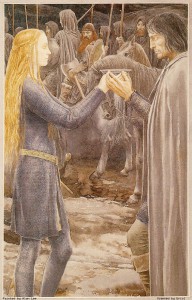
In this TORn library article Barliman chatter and Hall of Fire regular Puma examines one error regarding Aragorn’s age that was actually introduced in the transition to the revised editions, and has seemingly remained unnoticed ever since.
The tale of one word
The Lord of the Rings is a complex book with just as complex a history. Through all the revisions there is one error in the appendices that has persisted even into the 50th anniversary edition, which is the most correct version we have.
It is an error with far-reaching ramifications. And the error reflects the complex history of the writing of The Lord of the Rings by J.R.R. Tolkien.
Let’s go to Appendix A, section titled The North Kingdom and the Dúnedain. The very last line reads thus:
Aragorn indeed lived to be two hundred and ten years old, longer than any of his line since King Arvegil; but in Aragorn Elessar the dignity of the kings of old was renewed.
This line is in error, but actually as first written it was correct, but only because the line was then different.
All those who are familiar with old editions of The Lord of the Rings know that originally Aragorn lived to the age of 190 years. Arvegil, the king mentioned in the line in question, did live to be 190 years old so the line in question was correct in the original text.
Tolkien revised The Lord of the Rings in the mid-1960s and made many changes. The age of Aragorn was altered from 190 to 210 years of age. This was to make Aragorn’s age triple the old biblical standard of three score years and ten. But when the age of Aragorn was changed, the name Arvegil was left unaltered, though he only lived to be 190 years old.
Now you might be thinking how do we know the age of any of the kings, since this information is not included in The Lord of the Rings. All we have in The Lord of the Rings is the death date of the kings.
When The History of Middle-earth was published new data became available. Volume 12, The Peoples of Middle-earth, has a list of all the kings of Arnor and Gondor, including their age. When The Lord of the Rings was completed much text for the appendices was left out due to space restrictions. The complete king list was one of the sections trimmed.
Let’s look at some relevant information from that list:
Arvegil 1553-1743 lived 190 years
Celebrindor 1062-1272 lived 210 years
So now we can see to correct the line in question, Celebrindor must be substituted for Arvegil. Quite a simple thing, change the name of one king for another. I would urge Christopher Tolkien to make note of this, so our future editions of The Lord of the Rings will no longer have an error in that line.
However by making this change there are ramifications that alter the meaning.
Let’s take a look to see what those are.
First, let’s look at the Dúnedain during the lifespan of Arvegil. In the North, Arnor and its remnants had been under attack by Angmar for hundreds of years, continually weakening the state. Also the Great Plague had struck, ravaging the population of Cardolan. Gondor, by this time, had suffered through the Kin-strife and the Great Plague, two evils it never fully recovered from.

Celebrindor as we can see lived almost 500 years earlier. His reign was the last before the rise of Angmar (which happened during the rule of his son Malvegil). Gondor during the lifetime of Celebrindor was at the peak of its power, none of the three great evils had yet struck. So by Aragorn living 210 years, he was given a lifespan of a king who lived at a time when the Dúnedain were still strong.
The Chieftains previous to Aragorn had been living into their 150s, except for those who had died an untimely death (usually in battle). Only Eru Iluvatar has the power to alter the natural lifespan of one of the Children. By altering the lifespan of Aragorn a stability was given to the new age following the major upheaval of the War of the Ring. Also Aragorn’s age was made the same of the last king who had lived in the North, at a time when the Dúnedain were yet strong. Sort of a new beginning from before the time things started going downhill for the Dúnedain.
A minor ripple in the long symphony of the Great Music, but by doing so Eru added new hope into the new age.
Aragorn indeed lived to be two hundred and ten years old, longer than any of his line since King Celebrindor; but in Aragorn Elessar the dignity of the kings of old was renewed.
A tale of how the change in one word has implications to how we view Middle-earth. May you all find joy and dignity as you explore the saga of Middle-earth. Tolkien left us a gift we should all treasure.
Puma
Endnote: Whether J.R.R. Tolkien had the intent I imply, by changing Aragorn’s age is unknown. Only Christopher Tolkien is qualified to comment on this matter.
Puma does not blog, do message boards, or facebook, but can be found in Barliman’s chat at various times, everyday. Puma enjoys chatting about Middle-earth with all, and would enjoy your feedback.


